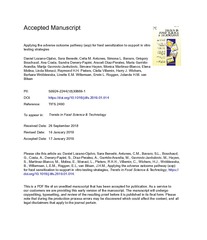Приказ основних података о документу
Applying the adverse outcome pathway (AOP) for food sensitization to support in vitro testing strategies
| dc.creator | Lozano-Ojalvo, Daniel | |
| dc.creator | Benedé, Sara | |
| dc.creator | Antunes, Celia M. | |
| dc.creator | Bavaro, Simona L. | |
| dc.creator | Bouchaud, Grégory | |
| dc.creator | Costa, Ana | |
| dc.creator | Denery-Papini, Sandra | |
| dc.creator | Díaz-Perales, Araceli | |
| dc.creator | Garrido-Arandia, María | |
| dc.creator | Gavrović-Jankulović, Marija | |
| dc.creator | Hayen, Simone | |
| dc.creator | Martínez-Blanco, Mónica | |
| dc.creator | Molina, Elena | |
| dc.creator | Monaci, Linda | |
| dc.creator | Pieters, Raymond | |
| dc.creator | Villemin, Clelia | |
| dc.creator | Wichers, Harry J. | |
| dc.creator | Wróblewska, Barbara | |
| dc.creator | Willemsen, Linette E.M. | |
| dc.creator | Roggen, Erwin L. | |
| dc.creator | van Bilsen, Jolanda H.M. | |
| dc.date.accessioned | 2019-04-05T14:57:41Z | |
| dc.date.available | 2020-01-17 | |
| dc.date.issued | 2019 | |
| dc.identifier.issn | 0924-2244 | |
| dc.identifier.uri | https://cherry.chem.bg.ac.rs/handle/123456789/2864 | |
| dc.description.abstract | Background: Before introducing proteins from new or alternative dietary sources into the market, a compressive risk assessment including food allergic sensitization should be carried out in order to ensure their safety. We have recently proposed the adverse outcome pathway (AOP) concept to structure the current mechanistic understanding of the molecular and cellular pathways evidenced to drive IgE-mediated food allergies. This AOP framework offers the biological context to collect and structure existing in vitro methods and to identify missing assays to evaluate sensitizing potential of food proteins. Scope and approach: In this review, we provide a state-of-the-art overview of available in vitro approaches for assessing the sensitizing potential of food proteins, including their strengths and limitations. These approaches are structured by their potential to evaluate the molecular initiating and key events driving food sensitization. Key findings and conclusions: The application of the AOP framework offers the opportunity to anchor existing testing methods to specific building blocks of the AOP for food sensitization. In general, in vitro methods evaluating mechanisms involved in the innate immune response are easier to address than assays addressing the adaptive immune response due to the low precursor frequency of allergen-specific T and B cells. Novel ex vivo culture strategies may have the potential to become useful tools for investigating the sensitizing potential of food proteins. When applied in the context of an integrated testing strategy, the described approaches may reduce, if not replace, current animal testing approaches. | |
| dc.publisher | Elsevier | |
| dc.relation | COST Action FA1402 entitled: Improving Allergy Risk Assessment Strategy for New Food Proteins (ImpARAS) | |
| dc.rights | embargoedAccess | |
| dc.rights.uri | https://creativecommons.org/licenses/by-nc-nd/4.0/ | |
| dc.source | Trends in Food Science and Technology | |
| dc.subject | Adverse outcome pathway | |
| dc.subject | Dendritic cells | |
| dc.subject | Epithelial cells | |
| dc.subject | IgE-mediated food allergy | |
| dc.subject | In vitro models | |
| dc.subject | T and B cells | |
| dc.title | Applying the adverse outcome pathway (AOP) for food sensitization to support in vitro testing strategies | |
| dc.type | article | |
| dc.rights.license | BY-NC-ND | |
| dcterms.abstract | Молина, Елена; Пиетерс, Раyмонд Х. Х.; Гавровић-Јанкуловић, Марија; Лозано-Ојалво, Даниел; Бенедé, Сара; Aнтунес, Целиа М.; Баваро, Симона Л.; Боуцхауд, Грéгорy; Цоста, Aна; Денерy-Папини, Сандра; Дíаз-Пералес, Aрацели; Гарридо-Aрандиа, Марíа; Хаyен, Симоне; Мартíнез-Бланцо, Мóница; Монаци, Линда; Виллемин, Цлелиа; Wицхерс, Харрy Ј.; Wрóблеwска, Барбара; Wиллемсен, Линетте Е.М.; Рогген, Ерwин Л.; ван Билсен, Јоланда Х.М.; | |
| dc.citation.volume | 85 | |
| dc.citation.spage | 307 | |
| dc.citation.epage | 319 | |
| dc.identifier.wos | 000460715700025 | |
| dc.identifier.doi | 10.1016/j.tifs.2019.01.014 | |
| dc.citation.rank | aM21~ | |
| dc.description.other | This is the peer-reviewed version of the following article: Lozano-Ojalvo, D.; Benedé, S.; Antunes, C. M.; Bavaro, S. L.; Bouchaud, G.; Costa, A.; Denery-Papini, S.; Díaz-Perales, A.; Garrido-Arandia, M.; Gavrovic-Jankulovic, M.; et al. Applying the Adverse Outcome Pathway (AOP) for Food Sensitization to Support in Vitro Testing Strategies. Trends Food Sci. Technol. 2019, 85, 307–319. [https://doi.org/10.1016/j.tifs.2019.01.014] | |
| dc.type.version | acceptedVersion | |
| dc.identifier.scopus | 2-s2.0-85061595592 | |
| dc.identifier.fulltext | https://cherry.chem.bg.ac.rs/bitstream/id/6623/10.1016@j.tifs.2019.01.014.pdf |


